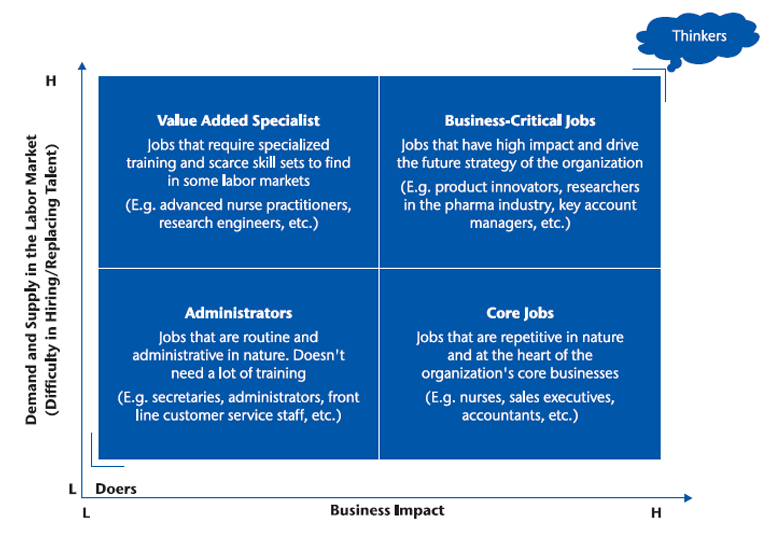
During transactions, organizations – even those who know from experience that the human capital aspects of a deal very often determine success or failure to achieve deal goals - struggle to come up with effective retention strategies. It is all too tempting for companies to overlook the matter of employee retention and trust that their top talent will stay onboard. Many organizations factor retention costs into their deal models, but this is mostly focused on senior executives and takes the form of a financial incentive paid at a specified time following the completion of a transaction.
Whether a merger, an acquisition, a spin-off , a divestiture or in fact any disruptive period for an organization, its employees have a variety of different concerns that will influence their desire to remain at the organization. It may be that those ‘key’ employees identified as eligible for retention incentives would stay anyway; there could be others who would have a critical role due to a specific set of skills but for whom no retention strategy is put in place.
A talented, cohesive and engaged workforce influences every aspect of a company’s performance, including revenue growth and productivity, so companies who neglect to understand who their most critical employees are risk putting their financial success in jeopardy. Aon studies have found that more than 60% of organizations said an inability to retain key employees contributed to deals not meeting their goals. Particularly during times of slower market conditions, organizations can have a false sense of security that employees are less likely to leave due to lack of other opportunities. Our experience shows this is not the case, as it is usually those most critical to the organization that will be able to find other opportunities most easily, all too often taking part of the deal value with them.
Often, particularly under the time pressure that is part and parcel of the transaction process, organizations focus their retention efforts on high potential employees and senior executives in business-critical roles, but it is also important to consider the broader population, where there are often individuals with specific technical or leadership skills that can have just as much impact on future success. A broader approach allows identification of areas of institutional knowledge, technical skills and internal and external relationships.
In many different areas of business, particularly in the recent years, segmentation has become a critical and effective tool used by business strategists to study various metrics and enable better alignment to strategy. Applying the same approach to the human capital of an organization in the form of workforce segmentation can be used to identify the business critical workforce. It is common to determine how critical employees are based on the size of an employee’s pay check, and in fairness it is a good starting point, given that many senior roles with higher salaries are strategically important. That said, higher pay should not be the only determinant of whether a role is critical or not. Even without the context of a deal, workforce segmentation allows an organization to understand its employees and how to ensure that they are remunerated and managed effectively. As the level of complexity in an organization increases, particularly as employees from different organizations come together in a transaction, the need for segmenting the workforce becomes more pronounced.
All employees are important and serve a purpose towards achieving organizational and deal objectives, but some are more critical, and workforce segmentation is helpful to:
- Recognize the business contribution these jobs make to the future of the organization
- Differentiate compensation levels to attract and retain talent in these jobs
- Proactively plan succession for these roles to minimize business disruption
- Determine appropriate retention strategies for different segments of the workforce
Broadly speaking, the workforce for most organizations can be segmented into four categories, by considering the scarcity of the skills they have and the business impact they have, as illustrated below.

Business-critical jobs are those that are critical to the next 5-10 years of the organization. In a technology company, design engineers or product engineers working on the “next big thing” would be considered business-critical. In the pharmaceutical industry, researchers working on the next big patent are critical to the survival and future growth of the organization. In a professional services organization, a key client manager entrusted with managing a strategically important account may be business-critical.
Leading organizations that achieve high rates of employee retention in the medium to long-term after a deal ensure that HR and business leaders work in collaboration right from the due diligence stage of a transaction to segment the workforce and determine the business-critical employees.
Questions HR can ask business leaders to help facilitate that decision making would include:
- Are these jobs working on projects/products that will drive the future growth of the business?
- Are these jobs performing activities others cannot do or are not equipped to do?
- If we lost someone in this job, will it result in business disruption or potential loss of revenue?
- Are these jobs doing something that has a direct impact on the reputation of the fi rm?
- Are these jobs contributing to building capability without which deal goals are threatened?
An organization’s approach to workforce segmentation should be aligned to its business and deal strategy; a flexible approach will ensure that any changes in the deal or post-closing strategy are reflected in a revision of the segmentation matrix.
Leading organizations that have a high success rate in M&A deals work with target leadership to identify critical employees. Asking some key questions allows those segmenting the workforce to determine what truly constitutes a critical employee.
Once workforce segmentation is completed, retention strategies can be determined, which will include but not be limited to financial incentives.
Equally important are areas such as benefits, alternative work schedules, career development opportunities, employee communication and organizational design. Taking a more holistic approach enables organizations to develop a strategy that retains employees beyond the period when they receive the final payout of a retention bonus.
All employees are different, and each has a different contribution to the business and different factors that motivate and drive them. The more an organization is able to understand these differences and nuances, the better will be the quality of its talent management framework and its retention planning. Workforce segmentation gives an organization the ability to fine-tune its talent, identify inefficiencies, develop talent in the right direction, and equip employees to contribute positively to the growth and success of the organization and achievement of deal goals.
Written by:
Javad Ahmad
Associate Partner & VP, Middle East,
Turkey & Africa Head
Aon Strategic Advisory
[email protected]
Associate Partner
Performance, Rewards & Talent
[email protected]
Get in touch
